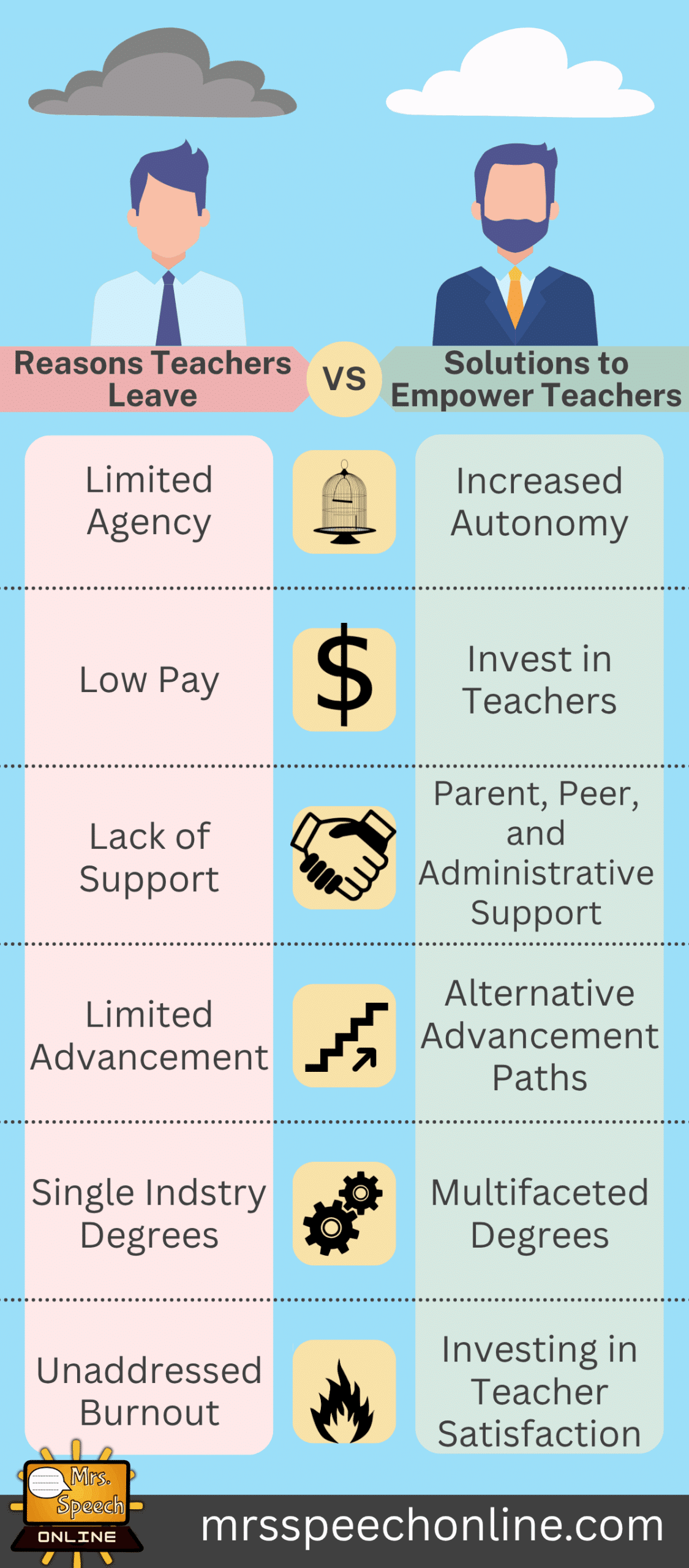The Flickering Spark of Passion
The spark of passion that ignites a love for teaching can flicker and fade when faced with relentless challenges. In Part 1, we explored the reasons why many dedicated educators stay despite the burnout and frustration. But simply acknowledging the problem isn’t enough. We need concrete solutions to create a system that empowers teachers, reignites their passion, and allows them to thrive. Let’s break the chains that hold them back. We must build a future where talented educators choose to stay and make a lasting impact.
Reimagine Retirement: Unlocking Mobility and Security
Teacher pensions are often cited as a reason educators stay put, even in the face of dissatisfaction. However, the current system can feel like a golden cage. Traditional pensions often lack portability, meaning the value accumulated is tied to a specific school district. This discourages teachers from seeking better opportunities elsewhere. They fear losing their hard-earned retirement savings. Solutions like portable pension plans or hybrid models would allow teachers to take their retirement security with them. This fosters greater mobility and career flexibility. It not only benefits teachers but also allows school districts to attract and retain top talent from a wider pool.
Multifaceted Degrees: Building Bridges Beyond the Classroom

Many teacher education programs focus primarily on pedagogy, leaving graduates inadequately prepared for a career change outside the classroom. This lack of transferable skills can feel like a dead end, trapping passionate educators in a system that no longer serves them. Universities and colleges can address this by offering multifaceted degrees. These programs would equip future educators with valuable skills beyond lesson planning and classroom management. Incorporating courses in project management, data analysis, communication, and educational technology would make teacher graduates valuable assets not only in the classroom but also in other industries. This flexibility provides teachers with a safety net. It empowers them to pursue opportunities outside education, if needed, while also enriching their skillset and making them potentially more effective educators.
Empowering Teachers: Reigniting Passion Through Autonomy

Micromanagement, standardized testing, and inflexible curriculums can stifle a teacher’s creativity and autonomy. This leads to a feeling of powerlessness and a disconnect from the core reason they entered the profession – to inspire and nurture young minds. Teacher autonomy is essential in fostering a positive learning environment.1
Teacher retention thrives in environments that nurture their ability to achieve success with students. This means a redesign of schools to prioritize strong relationships between educators, students, and families. Additionally, schools need to personalize education, tailoring learning experiences to individual student needs and learning styles. By fostering these elements, schools can create environments where both teachers and students flourish.2
Imagine a teacher who is passionate about environmental science being given the freedom to create a project-based learning experience. This experience could incorporate field trips, guest speakers, and hands-on activities. Similarly, an English teacher, upon discovering the majority of his class loves Star Wars, could create a curriculum around this shared passion. This autonomy allows teachers to innovate and engage students on a deeper level. Ultimately, they find joy in the teaching process. Furthermore, it fosters a sense of professionalism and trust. This leads to a more fulfilling work experience.
Alternative Advancement Paths: Leading from Within

The traditional career path in education often leads from teacher to administrator. However, this path may not appeal to every passionate educator. Some crave the connection with students and the magic of the classroom environment but lack the desire to move into a purely administrative role. Here’s where alternative advancement paths can be game-changers. Creating leadership opportunities within classrooms, such as lead teacher positions, curriculum specialist roles, or mentor programs, allows experienced and passionate educators to take on increased responsibility while staying connected to their core passion – teaching. These roles can involve mentoring new teachers, developing and leading professional development sessions, or specializing in specific curriculum areas. This system fosters collaboration and knowledge sharing. It allows educators to leverage their experience in ways that benefit their colleagues and students.
Investing in Teacher Happiness: A Ripple Effect on Student Success

Research shows a direct correlation between teacher well-being and student achievement.3 Stressed, burnt-out teachers simply cannot be as effective as those who feel supported and valued. Investing in teacher well-being is not just the right thing to do – it’s a smart investment in education as a whole.
Schools can prioritize teacher well-being by providing resources for stress management and mental health support. Flexible work arrangements, clear communication channels with administrators, and opportunities for professional development can all contribute to a more positive and supportive work environment. When teachers feel valued, supported, and empowered, this translates into a more engaging learning environment for students. Ultimately, this leads to better academic outcomes.
A Call to Action: Building a Brighter Future Together
The future of education rests on the shoulders of our teachers. Let’s break the chains that hold them back and build a system that fosters their passion and empowers their expertise. We must celebrate their dedication. Here’s what you can do to be a part of the solution:

- Share This Post: Let your friends, family, and colleagues know about the challenges and solutions facing teachers.
- Start a Conversation: Talk to your local school board members about the importance of supporting educators.
- Advocate for Change: Contact your state representatives and voice your support for policies that prioritize teacher well-being, professional development, and curriculum autonomy.
- Support Teacher Organizations: Get involved with organizations that advocate for teachers’ rights and well-being.
- Show Your Appreciation: Let your teachers know how much you value their hard work! A simple thank you or a note of appreciation can go a long way. It is valued more than flowers or candy.
By working together, we can create a system that empowers our educators. This allows them to make a lasting impact on the lives of their students. Imagine a future where classrooms are filled with passionate, engaged teachers who feel valued and supported. This is the future we can create, together.
Additionally, here are some resources for further exploration:
The National Education Association (NEA): https://www.nea.org/
The American Federation of Teachers (AFT): https://www.aft.org/
The National Commission on Teacher Certification (NCTC): https://www.nctq.org/
The National Board for Professional Teaching Standards (NBPTS): https://www.nbpts.org/certification/standards/
Let’s keep the conversation going! Share your thoughts and ideas in the comments below. What solutions would you propose to empower our teachers and ensure their well-being?
Social Media Icons: designed by rawpixel.com – Freepik.com
- Scarpino, C., Kilpatrick, C., & Santiago, P. (2022). Teacher voice and autonomy (OECD Education Working Papers No. 273). OECD Publishing. https://one.oecd.org/document/EDU/WKP(2022)14/en/pdf ↩︎
- Source: Darling-Hammond, L., DiNapoli, M., Jr., & Kini, T. (2023). The federal role in ending teacher shortages. Learning Policy Institute. https://doi.org/10.54300/649.892 ↩︎
- Dreer, B. (2023). On the outcomes of teacher wellbeing: A systematic review of research. Frontiers in Psychology, 14, Article 1205179. https://doi.org/10.3389/fpsyg.2023.1205179 ↩︎











